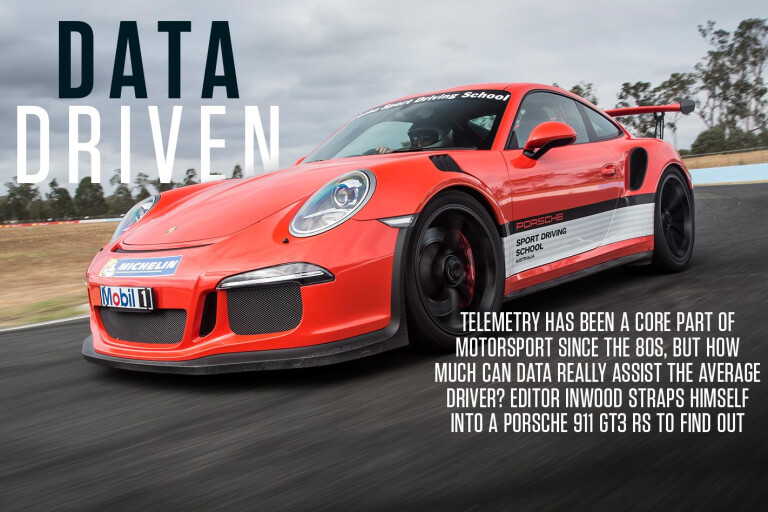
IT BEGINS, fittingly I guess, in a classroom.
Outside, not 10 metres away, sits ‘my’ Porsche 911 GT3 RS, resplendent in Lava Orange, its tyre pressures set just so, its flat six thrumming away as oils and vital fluids are brought to temperature.
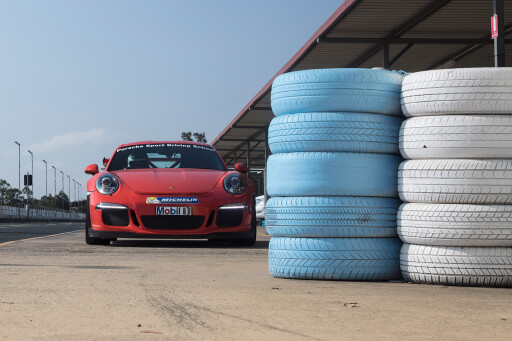
Beyond it, Queensland Raceway beckons, the promise of an entire day of instructed hoonery so tantalisingly close. But first, the required dose of medicine, delivered by Porsche’s chief driving instructor and touring car legend Tomas Mezera.
It’s designed, I deduce, to knock some of the confidence from our sails. Not that I have much left. The seeds of self-doubt are blowing my way, and the morning has been spent with some germinating in the concern that I’m about to be not so brilliant at something most car lovers desperately want to be brilliant at – driving quickly. After all, there’s no hiding today.
Porsche runs around 80 drive day programs in Australia each year, ranging from the entry-level $1540 Precision course, where punters can drive the Porsche range in a controlled, speed-limit-free environment, right through to the $6600 ‘GT3 Cup’ that provides Queensland Raceway, a slick-shod 991 Cup Car and your own race engineer for an entire day.
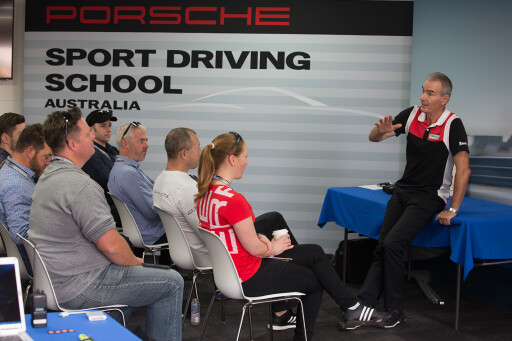
I’m at Porsche’s ‘Master’ drive day, the brand’s second-from-top offering that, for $3960, retains all of the ingredients of the GT3 Cup course, but swaps out the hardcore Cup Car for the more manageable 911 GT3 RS. Central to the day is telemetry, with data captured by the GT3 crunched and analysed by your racing engineer after each five- or 10-lap session. Here, speed traces, brake pressures and sector times are used to scrutinize your shortcomings and weaknesses in microscopic detail.
Like I said, no hiding.
However, Mezera is well practised at putting jangled nerves at ease.
“The most important thing today is to relax,” he says in his slow Czech accent. “It’s all about your attitude and approach. I can have [Fernando] Alonso here and he would go out and feel the car first, then hang its balls out. I expect the same from you lads.”
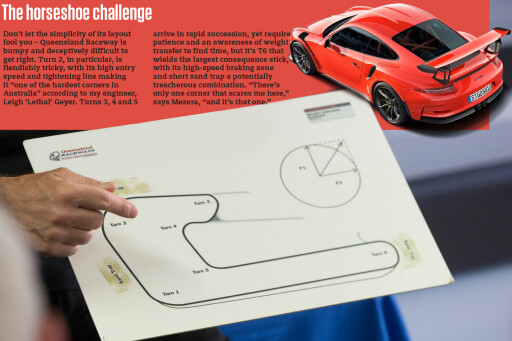
I begin to realise today isn’t about exposing my flaws, but about using data to find speed. About discovering where I’m bleeding time, and then providing the instruction to help me improve. The day’s single focus is to make me faster. I relax. I’m in.
Ably supporting Mezera are 2017 Bathurst 1000 winner Luke Youlden and freshly minted Touring Car Masters champion Steve Johnson, who are given the task of being our hands-on instructors for the day.
I’m assigned Johnson and the instruction begins, not in the GT3, but a dog-eared Cayenne. Johnson is at the wheel, me pinned in the passenger seat as he gives me my first proper look at the track’s deceptively simple layout.
Arranged like a giant horseshoe, we’re using the shorter Clubman circuit, a brief lap of just six corners that offers a blend of high-speed, big-commitment sweepers and tight, technical turns. It’s fast, bumpy and its entire 2.11km length can be seen from a single vantage point, so is perfect for this kind of instruction. To Johnson’s relief, I’ll be driving the GT3 solo, with tuition provided over the radio from the pit wall.
“It’s all about being smooth and keeping your vision up,” says Johnson as he tips the Cayenne into the big commitment Turn 1 with one finger on the wheel. “We just went through there faster than most of our customers do.”
My first solo stint in the GT3 is overly cautious. I’m learning the circuit and also learning the car, having never driven a GT3 RS before, or any GT 911 for that matter.
It doesn’t take long before I feel comfortable. Porsche’s $387,300 GT3 RS is friendly, progressive and predictable, with huge grip at the rear axle and a howling, evocative soundtrack. I’m instantly reassured this isn’t a car I need to ‘learn’, but rather one where I can focus on myself without having to second guess how the car will respond to my inputs.
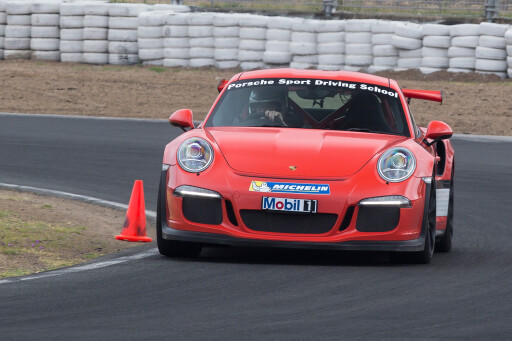
After five exploratory laps, I head in for my first session with my engineer, Leigh ‘Lethal’ Geyer. An Aussie touring car veteran, Leigh has engineered for Tony Longhurst and Dick Johnson Racing, and now discovers Carrera Cup talent at McElrea Racing.
With the laptop’s hard drive humming, Leigh reveals my fastest time is a 64.1sec, which unsurprisingly, is hopelessly slow. Lethal doesn’t sugar coat it; he says most Porsche owners who regularly track their cars manage a high 61 or low 62sec by the end of the day.
Time to find, then, and the secrets to unlocking it lurk in the data. Initially the speed traces are confusing, like colourful mountains that rise and fall in jagged little steps, but with Lethal’s help, they begin to make sense. My time is overlaid with a 59.1sec delta set by Mezera and it’s obvious where I’m losing time. Braking is my biggest weakness, with my initial application too soft.
I need to carry more brake into the corner, too, with Leigh explaining I should divide the braking phase into two parts: a big application that hovers just on the edge of ABS to wash off 80 percent of my speed, then slowly bleed off the pedal as I add more steering lock.
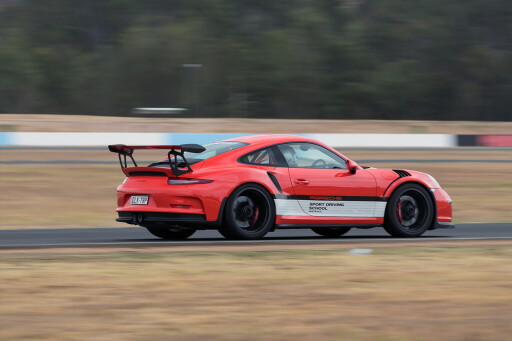
Mezera adds “These cars are very sensitive to pitch, so make the weight transfer as smooth as possible. Control how you get off the brake pedal; the smoother you are, the more grip you’ll have.”
I’m discovering other quirks with the GT3 too, despite my initial confidence. Mounting the engine behind the rear axle means it’s prone to oversteer if you brake too hard or too late with lock applied, and I’m also encountering power understeer through the slower Turn Four and Five complex as I greedily feed in the throttle in a misguided attempt to go faster. Patience and decisive, smooth inputs are the cure for both issues.
My second five-lap session slices 3.0sec from my time, and before lunch, I head out for the first of three 10-lap stints. It’s here I discover first hand how much the weather and track temperature can impact lap times. With the sun hidden behind thick cloud and the ambient temp hovering in the low 20s, grip levels spike and everyone goes faster, with my best effort a 60.2sec.
Still, I’m demoralised at lunch. Others in the course have gone more than a second faster, and I’m starting to bump into my talent threshold, my last session relying on the GT3’s deftly calibrated electronics to save me from some ham-fisted inputs at more than 120km/h.
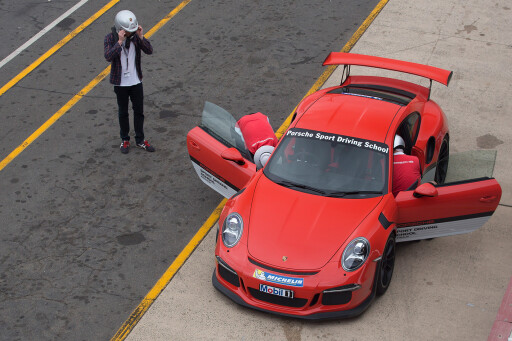
Lethal’s instruction helps.
“You’re textbook into Turn 1 and through Turn 6, but there’s lots of time to find at the exit of Turn 1 and Turn 2,” he says. “You need to be braver.”
The real turning point, however, arrives just before I head out for my final two 10 lap stints. Perhaps sensing my frustration, Johnson takes me for a passenger ride in the GT3 RS and it’s here where things begin to click. Seeing Mezera’s speed trace and understanding what the car is capable of on a computer screen is one thing, but experiencing it first hand, and feeling how smooth Johnson is and how much lateral load the car can take, is a light bulb moment.
My next session is my best yet. Consistent and relaxed, I manage a string of 59.5sec laps by piecing together all of the day’s advice: vision up, stay calm, late on the brake, carry as much speed to the apex as possible, rotate the car and then patiently feed in the throttle.

It feels good and despite a sharp rise in track temp and a drop in grip levels, I’m the only one to go faster in the afternoon. I finish with a 59.3sec, which Lethal makes all the brighter by using our final debrief to reveal “with the track temp up so much and the direct sunlight, the track is now at least half a second slower, so your time is really a high 58sec.”
I’m stoked, though the day has taken its toll. I’m mentally shagged, the day-long process of driving flat out while learning new skills illuminating, though utterly exhausting.
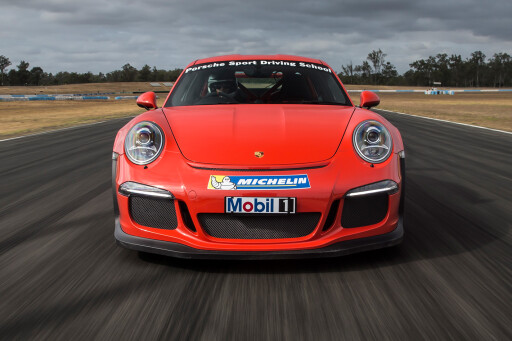
I expected to see the same fatigue from the car and yet, despite more than 40 laps of punishment, the GT3 looks and feels as fresh as it did this morning. Faultlessly reliable and without a hint of brake fade, the only performance part to degrade were the Michelin Pilot Sport Cup 2s, which began to lose their crisp edges and lateral grip late in the day.
So it ends in pitlane, the GT3 RS ticking and pinging as it cools, me nursing a slight headache as I relive the day and ponder how much money I’d need to spend on performance-part upgrades for a 911 GT3 RS to slash six seconds from my lap time.
A lot more than $3960, I bet.





COMMENTS